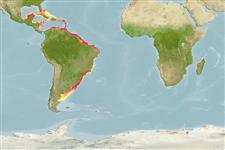Environment: milieu / climate zone / depth range / distribution range
Écologie
marin; saumâtre démersal; profondeur ? - 190 m (Ref. 47377), usually 18 - 70 m (Ref. 5217). Subtropical; 26°N - 53°S, 98°W - 34°W
Western Atlantic: Belize and Jamaica southward to Argentina Antilles, Central and South America (Ref. 26938).
Length at first maturity / Taille / Poids / Âge
Maturity: Lm 26.2 range ? - ? cm
Max length : 45.0 cm TL mâle / non sexé; (Ref. 104706); 45.0 cm TL (female); common length : 30.0 cm TL mâle / non sexé; (Ref. 3822); poids max. publié: 349.90 g (Ref. 131022)
Épines dorsales (Total) : 9 - 10; Rayons mous dorsaux (Total) : 11 - 12; Épines anales: 1; Rayons mous anaux: 10.
Found on sand or muddy bottoms of the continental and insular shelves. Occasionally occurs over reefs. Feeds on shrimps, crabs, other crustaceans and fishes. Traded as an aquarium fish at Ceará, Brazil (Ref. 49392).
Life cycle and mating behavior
Maturité | Reproduction | Frai | Œufs | Fécondité | Larves
Miller, G.C. and W.J. Richards, 1978. Triglidae. In W. Fischer (ed.) FAO species identification sheets for fishery purposes. West Atlantic (Fishing Area 31). FAO, Rome. Vol. 5. pag.var. (Ref. 3822)
Statut dans la liste rouge de l'IUCN (Ref. 130435: Version 2024-2)
Menace pour l'homme
Harmless
Utilisations par l'homme
Pêcheries: intérêt commercial mineur; Aquarium: Commercial
Outils
Articles particuliers
Télécharger en XML
Sources Internet
Estimates based on models
Preferred temperature (Ref.
123201): 15 - 27.9, mean 26.1 °C (based on 464 cells).
Phylogenetic diversity index (Ref.
82804): PD
50 = 0.5000 [Uniqueness, from 0.5 = low to 2.0 = high].
Bayesian length-weight: a=0.00933 (0.00762 - 0.01143), b=3.00 (2.95 - 3.05), in cm total length, based on LWR estimates for this species (Ref.
93245).
Niveau trophique (Ref.
69278): 3.8 ±0.63 se; based on food items.
Generation time: 8.5 ( na - na) years. Estimated as median ln(3)/K based on 1
growth studies.
Résilience (Ref.
120179): Faible, temps minimum de doublement de population : 4,5 à 14 années (K=0.13).
Fishing Vulnerability (Ref.
59153): High vulnerability (57 of 100).
Nutrients (Ref.
124155): Calcium = 68.1 [36.1, 163.5] mg/100g; Iron = 0.978 [0.538, 1.847] mg/100g; Protein = 17.4 [15.1, 20.4] %; Omega3 = 0.584 [0.275, 1.520] g/100g; Selenium = 30 [14, 70] μg/100g; VitaminA = 15.6 [6.0, 39.3] μg/100g; Zinc = 0.885 [0.634, 1.252] mg/100g (wet weight);
